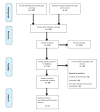Enteral Nutrition Interruptions in the Intensive Care Unit: A Systematic Review of Frequency, Causes, and Nutritional Implications
- PMID: 40337584
- PMCID: PMC12057588
- DOI: 10.7759/cureus.81834
Enteral Nutrition Interruptions in the Intensive Care Unit: A Systematic Review of Frequency, Causes, and Nutritional Implications
Abstract
Enteral nutrition interruptions (ENIs) are a major cause of inadequate nutrition goals in critically ill patients. The aim of this systematic review was to provide an update on the various clinical and logistical reasons for ENIs and observe their nutritional implications. PubMed, MEDLINE, Embase, and The Cochrane Library were searched from the inception of each database until March 11, 2024. For data extraction, a structured checklist was used. The initial literature search yielded 522 results. In total, 26 studies were included, comprising 3067 participants. Among the included studies, there were 20 prospective studies, two before-and-after studies, one RCT, and three retrospective studies. The main reasons for ENI were high gastric residual volumes, nasogastric tube dysfunction, and diagnostic and surgical procedures. In conclusion, although the nutritional management of critically ill patients in the ICU has improved drastically, ENIs remain a major problem in clinical practice. Future research should consider different treatments and ICU protocols. Additionally, there is a need for standardized ENI definitions and standardized reporting of the evaluation of energy and/or protein requirements, objectively determining adequate intake, and reporting the causes, frequency, and duration of ENIs.
Keywords: critical care; enteral nutrition; enteral nutrition interruption; intensive care; malnutrition; underfeeding; undernutrition.
Copyright © 2025, Pouwels et al.
Conflict of interest statement
Conflicts of interest: In compliance with the ICMJE uniform disclosure form, all authors declare the following: Payment/services info: All authors have declared that no financial support was received from any organization for the submitted work. Financial relationships: All authors have declared that they have no financial relationships at present or within the previous three years with any organizations that might have an interest in the submitted work. Other relationships: All authors have declared that there are no other relationships or activities that could appear to have influenced the submitted work.
Figures
Similar articles
-
Impact of enteral nutrition interruptions on underfeeding in intensive care unit.Clin Nutr. 2021 Mar;40(3):1310-1317. doi: 10.1016/j.clnu.2020.08.014. Epub 2020 Aug 27. Clin Nutr. 2021. PMID: 32896448
-
Enteral nutrition interruptions in the intensive care unit: A prospective study.Nutrition. 2022 Apr;96:111580. doi: 10.1016/j.nut.2021.111580. Epub 2021 Dec 26. Nutrition. 2022. PMID: 35101813
-
Causes and impacts of interrupted enteral nutrition in critically ill patients: A secondary analysis of a cluster-randomized controlled trial.Nurs Crit Care. 2025 Mar;30(2):e70006. doi: 10.1111/nicc.70006. Nurs Crit Care. 2025. PMID: 40069998 Clinical Trial.
-
Why patients in critical care do not receive adequate enteral nutrition? A review of the literature.J Crit Care. 2012 Dec;27(6):702-13. doi: 10.1016/j.jcrc.2012.07.019. Epub 2012 Oct 17. J Crit Care. 2012. PMID: 23084129 Review.
-
Interruptions in enteral nutrition delivery in critically ill patients and recommendations for clinical practice.Crit Care Nurse. 2014 Aug;34(4):14-21; quiz 22. doi: 10.4037/ccn2014243. Crit Care Nurse. 2014. PMID: 25086090 Review.
References
-
- ESPEN guidelines on definitions and terminology of clinical nutrition. Cederholm T, Barazzoni R, Austin P, et al. Clin Nutr. 2017;36:49–64. - PubMed
-
- ESPEN guideline on clinical nutrition in the intensive care unit. Singer P, Blaser AR, Berger MM, et al. Clin Nutr. 2019;38:48–79. - PubMed
-
- Impact of enteral nutrition interruptions on underfeeding in intensive care unit. Salciute-Simene E, Stasiunaitis R, Ambrasas E, et al. Clin Nutr. 2021;40:1310–1317. - PubMed
-
- Energy and protein deficits throughout hospitalization in patients admitted with a traumatic brain injury. Chapple LS, Deane AM, Heyland DK, Lange K, Kranz AJ, Williams LT, Chapman MJ. Clin Nutr. 2016;35:1315–1322. - PubMed
Publication types
LinkOut - more resources
Full Text Sources

